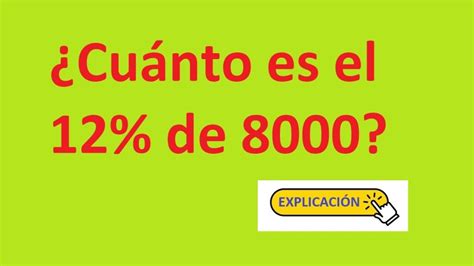Cual Es El 10 Por Ciento De 1000
Kalali
Apr 01, 2025 · 4 min read

Table of Contents
What is 10 Percent of 1000? A Comprehensive Guide to Percentages
Calculating percentages is a fundamental skill in various aspects of life, from budgeting and shopping to understanding financial reports and academic assessments. Knowing how to quickly and accurately determine percentages empowers you to make informed decisions and navigate numerical information with ease. This comprehensive guide will delve into the calculation of "what is 10 percent of 1000," explaining the process, providing alternative methods, and exploring practical applications.
Understanding Percentages
Before we tackle the specific calculation, let's establish a clear understanding of percentages. A percentage is a fraction or ratio expressed as a number out of 100. The symbol "%" represents "percent," meaning "out of 100" or "per hundred." Therefore, 10% signifies 10 out of 100, which can be written as the fraction 10/100 or the decimal 0.10.
Calculating 10% of 1000: The Basic Method
The most straightforward method for calculating 10% of 1000 involves converting the percentage to a decimal and then multiplying it by the whole number.
Here's how:
-
Convert the percentage to a decimal: 10% is equivalent to 0.10 (divide the percentage by 100).
-
Multiply the decimal by the whole number: 0.10 * 1000 = 100
Therefore, 10% of 1000 is 100.
Alternative Methods: Different Approaches to the Same Solution
While the basic method is efficient, understanding alternative approaches can enhance your problem-solving skills and provide flexibility depending on the complexity of the percentage calculation.
Method 2: Using Fractions
Percentages can be expressed as fractions. 10% is equivalent to 10/100, which simplifies to 1/10.
To calculate 10% of 1000 using this method:
-
Express the percentage as a fraction: 10% = 1/10
-
Multiply the fraction by the whole number: (1/10) * 1000 = 100
This method clearly illustrates that finding 10% is the same as finding one-tenth of a number.
Method 3: Proportions
Proportions offer a powerful tool for solving percentage problems, especially when dealing with more complex scenarios. We can set up a proportion to solve for 10% of 1000:
-
Set up the proportion: x/1000 = 10/100 (where 'x' represents 10% of 1000)
-
Cross-multiply: 100x = 10000
-
Solve for x: x = 10000/100 = 100
This method reinforces the relationship between the percentage, the part, and the whole.
Practical Applications: Real-World Examples
Understanding percentage calculations is crucial for various real-life scenarios. Here are some examples showcasing the practical application of finding 10% of 1000:
-
Sales Tax: Imagine you're purchasing an item costing $1000, and the sales tax is 10%. Calculating 10% of $1000 ($100) will help you determine the exact amount of tax you'll be paying.
-
Discounts: If a store offers a 10% discount on a $1000 item, calculating 10% of $1000 ($100) determines the discount amount, enabling you to calculate the final price easily.
-
Tips: When calculating a 10% tip on a $1000 bill, you would simply calculate 10% of $1000 to find the tip amount.
-
Commission: If a salesperson earns a 10% commission on sales, and they make $1000 in sales, calculating 10% of $1000 determines their commission earnings.
-
Financial Analysis: In financial statements and reports, understanding percentage changes and calculations is fundamental for analyzing growth, profitability, and other key financial metrics. Calculating percentages helps to understand the relative changes and make informed decisions.
Beyond the Basics: Calculating Other Percentages of 1000
The methods described above can be easily adapted to calculate other percentages of 1000. For example, to calculate 25% of 1000:
-
Convert to decimal: 25% = 0.25
-
Multiply: 0.25 * 1000 = 250
Or, using fractions: 25% = 25/100 = 1/4. (1/4) * 1000 = 250
Mastering Percentage Calculations: Tips and Tricks
Here are some tips to improve your percentage calculation skills:
-
Memorize common percentages: Familiarize yourself with common percentage equivalents like 10% = 0.1, 25% = 0.25, 50% = 0.5, and 75% = 0.75. This will make calculations faster and more intuitive.
-
Use a calculator effectively: While mental math is valuable, utilize a calculator for larger numbers or complex calculations.
-
Practice regularly: Consistent practice is key to mastering any skill, including percentage calculations.
-
Break down complex calculations: If you encounter a complex percentage problem, break it down into smaller, manageable steps.
-
Understand the context: Always understand the context of the percentage problem to ensure you're applying the correct method and interpreting the results correctly.
Conclusion: The Power of Percentage Calculations
Understanding how to calculate percentages is a valuable skill applicable in numerous aspects of daily life. This guide has demonstrated various methods for calculating "what is 10 percent of 1000," providing a foundation for tackling a wide range of percentage problems. By mastering these techniques and utilizing the provided tips and tricks, you'll be equipped to confidently approach and solve percentage calculations in any context. Remember that consistent practice is crucial for developing fluency and efficiency in this essential mathematical skill. Now, go forth and conquer the world of percentages!
Latest Posts
Latest Posts
-
Is Toasting Bread A Physical Or Chemical Change
Apr 02, 2025
-
Dos Pares De Angulos Alternos Internos Ejemplos
Apr 02, 2025
-
How To Find Mean In Stem And Leaf Plot
Apr 02, 2025
-
What Is The Lowest Common Multiple Of 4 And 9
Apr 02, 2025
-
What Is The Equation For Photosynthesis And Cellular Respiration
Apr 02, 2025
Related Post
Thank you for visiting our website which covers about Cual Es El 10 Por Ciento De 1000 . We hope the information provided has been useful to you. Feel free to contact us if you have any questions or need further assistance. See you next time and don't miss to bookmark.
